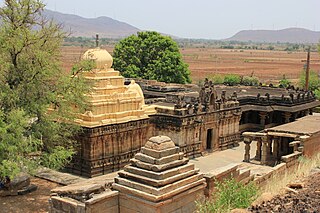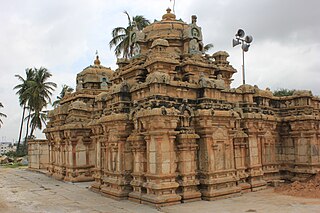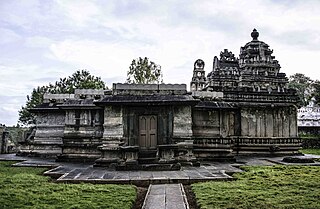
The Someshwara temple, situated in Kolar town of Karnataka state, India, is an ornate 14th century Vijayanagara era Dravidian style construction. Someshwara, another name for the Hindu god Shiva is the presiding deity in the temple. The temple is protected by the Archaeological Survey of India as a monument of national importance.

The Ranganthaswamy temple in Srirangapatna, in the Mandya district of Karnataka state, India, is dedicated to the Hindu god Ranganatha. It is one of the five important pilgrimage sites of Smartha -BaboorKamme & Sri Vaishnavism along the river Kaveri for devotees of Ranganatha. These five sacred sites are together known as Pancharanga Kshetrams in Southern India. Since Srirangapatna is the first temple starting from upstream, the deity is known as Adi Ranga. The town of Srirangapatna, which derives its name from the temple, is located on an island in the river Kaveri.

Bucesvara temple, also referred to as the Buceswara, Bucheshwara or Bhucheshvara temple, is a 12th-century Hindu temples in Koravangala village, Karnataka, India. The most sophisticated historical temple in the village, it is considered to be the flag-bearer of Hoysala architecture and was built by a wealthy patron named Buchi during the reign of king Ballala.

The Gaurishvara Temple is located in the town of Yelandur, Chamarajanagar district of Karnataka state, India. The temple was constructed by a local chief Singedepa Devabhupala of the Hadinadu chiefdom, a feudatory of the 16th century Vijayanagara Empire.

The Kalleshvara temple is located in the town of Ambali in Bellary district of Karnataka state, India. According to an Old Kannada inscription placed in the sabhamantapa, the temple was constructed during the reign of the Western Chalukya Empire King Vikramaditya VI. This temple is protected as a monument of national importance by the Archaeological Survey of India.

The Mallikarjuna temple is located in the town of Kuruvatti in the Bellary district of Karnataka state, India. The temple was constructed in the early 12th century rule of the Western Chalukya Empire. The temple is protected as a monument of national importance by the Archaeological Survey of India.

The Kaitabheshvara temple is located in the town of Kubatur, near Anavatti in the Shimoga district of Karnataka state, India. The temple was constructed during the reign of Hoysala King Vinayaditya around 1100 AD. The Hoysala ruling family was during this time a powerful feudatory of the imperial Western Chalukya Empire ruled by King Vikramaditya VI. According to the Archaeological Survey of India, the architectural signature of the temple is mainly "Chalukyan". Art historian Adam Hardy classifies the style involved in the construction of the temple as "Later Chalukya, non mainstream, far end of spectrum". The building material used is soapstone The temple is protected as a monument of national importance by the Archaeological Survey of India.

Kalleshvara temple is located in the town of Bagali near to Harpanahalli town in the Davangere district of Karnataka state, India.

Kedareshwara Temple is a Hoysala era construction in the historically important town of Halebidu, in the Hassan district of Karnataka state, India. It is located a short distance away from the famous Hoysaleswara Temple. The temple was constructed by Hoysala King Veera Ballala II and his Queen Ketaladevi, and the main deity is Ishwara. The temple is protected as a monument of national importance by the Archaeological Survey of India.

Panchalingeshwara Temple in Govindanahalli, Mandya district, Karnataka state, India, was constructed around 1238 A.D. during the reign of the Hoysala empire King Vira Someshwara. The name "Panchalingeshwara" literally means "five linga". The temple is protected as a monument of national importance by the Archaeological Survey of India. The famous sculptor of Hoysala times, Ruvari Mallitamma, is known to have made contributions to the temple.

The Nageshvara temple complex is located in Begur, a small town within the Bangalore urban district of Karnataka state, India. From inscriptions, it is known that Begur was once called Veppur, and Kelele. Two shrines within the temple complex, the Nageshvara and Nageshvarasvami were commissioned during the rule of Western Ganga Dynasty Kings Nitimarga I and Ereyappa Nitimarga II. The remaining shrines are considered a later day legacy of the rule of the Chola Dynasty over the region. An Old Kannada inscription, dated c. 890, that describes a "Bengaluru war" was discovered in this temple complex by the epigraphist R. Narasimhachar. The inscription is recorded in "Epigraphia Carnatica". This is the earliest evidence of the existence of a place called Bengaluru.

The Rameshvara temple is a 12th-century Shiva temple in Kudli, Shimoga district, Karnataka India. It is an early non-ornate, Hoysala construction with simpler Vesara style. The village of Koodli – also spelled Kudli, Kudali – was a major town through the 14th-century and of great antiquity, with ruins of over eight major Hindu temples and monasteries. It is located about 18 kilometres (11 mi) north-east of Shimoga city, the district headquarters. The town gets its name because it is situated at the confluence of the Tunga and Bhadra tributaries that form the Tungabhadra river.

The Saumyakeshava temple at Nagamangala was constructed in the 12th century by the rulers of the Hoysala empire. Nagamangala is a town in the Mandya district of Karnataka state, India. It is located 62 km from the historically important town Mysore, on the Srirangapatna-Sira highway. Historically, Nagamangala came into prominence during the rule of Hoysala King Vishnuvardhana when it became an important center of Vaishnava faith and received patronage from one of his queens, Bommaladevi. During the rule of Veera Ballala II, Nagamangala prospered as an agrahara and had the honorific Vira Ballala Chaturvedi Bhattaratnakara. The temple is protected as a monument of national importance by the Archaeological Survey of India.

The Nagareshvara Temple, also called the Aravattarukmbhada Gudi is a 12th-century Western Chalaukya construction. Bankapura is located in the Haveri District of Karnataka state, India. According to the Archaeologist Henry Cousens (1854–1933), during medieval times, the Bankapura fort was considered one of the most important fortifications in the Karnataka region. According to Cousens, the temple suffered much damage when Bankapura fell to the armies of Firoz Shah Bahamani in 1406 CE and later again when it was occupied by the Bijapur Sultan Adil Shah. According to the writings of Farishtah, the Sultan "ordered a superb temple within the fort to be destroyed". However, despite much pillage, the large temple with its majestic "great" hall (mantapa) still retains some of its original beauty. That the temple was built in honor of the Hindu god Shiva comes from two short inscriptions in the temple which begin with a salutation to "Shambu". There are other inscriptions in the temple, two of which are dated 1138 CE and one dated 1091 that record grants to the god "Nagaresvaradeva". The temple is protected as a monument of national importance by the Archaeological Survey of India.

Bhoganandiswara Temple and Arunachaleswara Temple are a twin Hindu temples complex located in Nandi village in Chikkaballapur district of Karnataka, India. Ornate, beautifully carved and dedicated to Shiva, they have been variously dated between the 9th- to 10th-century CE.

The Ramalingeshwara group of temples, situated in Avani town of the Kolar district, Karnataka state, India, is constructed in the dravida style. According to the Archaeological Survey of India (ASI), the temple is an ornate 10th-century Nolamba dynasty construction which was partially renovated later by the Chola dynasty.The Vijayanagara kings was built Main Mandapam and Rajagopuram. The temple is protected by the Archaeological Survey of India as a monument of national importance.

The Group of temples at Talakad, located about 45 km south-east of the culturally important city of Mysore in the Karnataka state of India are ancient Hindu temples built by multiple South Indian dynasties. Archaeological excavations of the sand dunes at Talakad have shown the existence of several ruined temples built during the rule of the Western Ganga dynasty (c.345-999). However, according to historian I. K. Sarma, only two temples, the Pataleshvara and Maraleshvara, built during the reign of King Rachamalla Satyavakya IV (r.975-986) are intact. According to the Archaeological Survey of India (ASI), the Vaidyeshvara temple, the largest, the most intact and ornate of the group bears Ganga-Chola-Hoysala architectural features. Its consecration is assignable to the 10th century with improvements made up to the 14th century. According to the art historian Adam Hardy, the Kirtinarayana temple was built in 1117 A.D. by the famous Hoysala King Vishnuvardhana to celebrate his victory over the Cholas in the battle of Talakad. It has currently been dismantled by the ASI for renovation. Only its mahadwara is intact. The Sand dunes of Talakad are protected by the Karnataka state division of the ASI. The Vaidyeshvara and Kirtinarayana temples are protected as monuments of national importance by the central Archaeological Survey of India.

The Arakeshvara Temple, dedicated to the Hindu god Shiva, is located in the village of Hole Alur in the Chamarajanagar district of Karnataka state, India. According to the historian Sarma, the temple which dates back to the middle of the 10th century rule of the Western Ganga Dynasty appears to have been renovated in later periods. It was constructed by King Butuga II around 949 A.D. to celebrate his victory over the Cholas of Tanjore in the historically important battle of Takkolam. It was a military engagement between crown prince Rajaditya, son of the Chola King Parantaka I, and King Butaga II. The temple is protected as a monument of national importance by the central Archaeological Survey of India.

The Bhimeshvara temple is a temple in the town of Nilagunda in the Davangere district of Karnataka state, India.

Govindanahalli is a small village in Mandya district of Karnataka state, southern India.





















